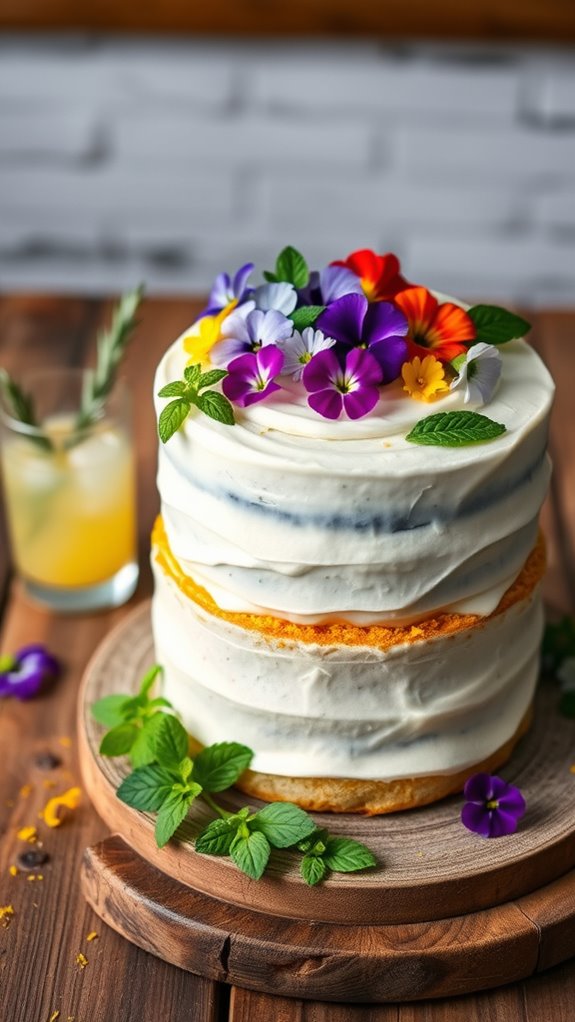When you think of a cake, you might picture classic flavors and decorations. But have you considered the enchanting world of botanical cakes? These creations blend the elegance of edible flowers and herbs with delectable flavors, transforming any celebration into a sensory delight. From their Victorian roots to modern interpretations, there's so much to explore. What makes these cakes not just visually stunning but also unique in taste? Let's uncover the layers behind this beautiful trend.
History
When you look at a botanical cake, you mightn't realize the rich history that accompanies this delightful creation.
Originating during the Victorian Era, these cakes reflect a time when floral symbolism became increasingly significant in society. Bakers began incorporating edible flowers, showcasing not just artistry, but also the deeper meanings behind the blooms. Each flower carried its own unique symbolism, such as love, friendship, or remembrance.
The delicate designs mirrored the intricate lacework common in Victorian fashion, making these cakes a stunning centerpiece at gatherings.
As you admire the vibrant florals on your cake, you're not just enjoying a treat; you're experiencing a slice of history filled with emotion and cultural significance that still resonates today.
Recipe

Creating a botanical cake is a delightful way to celebrate nature's beauty through the art of baking. This exquisite dessert not only tastes fantastic but also offers a stunning presentation that can elevate any occasion. By incorporating edible flowers and fresh herbs, you can infuse your cake with lovely flavors that complement the sweetness of the batter.
Whether for a garden party, a wedding, or simply to bring a bit of beauty into your everyday dessert, a botanical cake is an inspired choice.
To achieve the perfect balance of flavors and aesthetics, opt for a light, fluffy cake base that pairs well with the vibrant notes of your chosen botanicals. Consider using ingredients like lemon zest, vanilla, and buttermilk in the batter for a revitalizing twist. Additionally, a whipped frosting infused with herbal notes or floral essences can further enhance the cake's appeal.
Below, you'll find a straightforward recipe to create your own botanical masterpiece.
Ingredients:
- 2 cups all-purpose flour
- 1 ½ cups granulated sugar
- ½ cup unsalted butter, softened
- 1 cup buttermilk
- 3 large eggs
- 1 tbsp baking powder
- ½ tsp salt
- Zest of 1 lemon
- 1 tsp vanilla extract
- Edible flowers (e.g., violets, nasturtiums, or pansies)
- Fresh herbs (e.g., mint or rosemary), finely chopped
Instructions:
Begin by preheating your oven to 350°F (175°C) and greasing two 9-inch round cake pans. In a large mixing bowl, cream together the butter and sugar until light and fluffy.
Add the eggs one at a time, beating well after each addition. Mix in the lemon zest and vanilla extract. In a separate bowl, combine the flour, baking powder, and salt. Gradually add this dry mixture to the wet ingredients, alternating with the buttermilk until just combined.
Gently fold in your choice of edible flowers and fresh herbs. Divide the batter evenly between the prepared pans and bake for 25-30 minutes or until a toothpick inserted in the center comes out clean. Allow the cakes to cool in the pans for 10 minutes before transferring them to a wire rack to cool completely.
Extra Tips:
When selecting edible flowers, verify they're pesticide-free and safe for consumption.
Consider experimenting with different flower varieties and herb pairings to create unique flavor profiles that match the season or event. For decoration, use additional fresh herbs and flowers to top the frosting, making your botanical cake eye-catching and inviting.
Don't be afraid to play around with different frostings like lemon or elderflower to enhance the natural flavors of the cake. Happy baking!
Nutritional Guide
While indulging in a botanical cake, it's essential to reflect on its nutritional aspects to guarantee a balanced experience.
Emphasizing ingredient selection can enhance the nutrient benefits of your cake. Opt for whole grains like oat flour or almond flour to boost fiber content, which aids digestion. Adding natural sweeteners, such as honey or maple syrup, reduces refined sugar intake while contributing vitamins and minerals.
Incorporating fruits such as berries or citrus not only adds vibrant flavors but also packs in antioxidants.
You'll also want to include herbs like lavender or rosemary, enriching your cake with essential oils that promote overall wellness.
Ultimately, mindful choices lead to a delightful treat that nourishes your body and satisfies your sweet tooth.
Final Thought
As you savor a slice of botanical cake, consider how this delightful creation intertwines indulgence with nourishment.
Each bite bursts with unique flavor combinations, showcasing the vibrant essence of fresh herbs and fruits. The cake decoration, adorned with edible flowers and greenery, transforms your dessert into a stunning centerpiece.
You're not just enjoying a treat; you're experiencing a celebration of nature's bounty. This innovative approach to cake blends culinary artistry with healthy ingredients, making it a perfect choice for any occasion.
Whether you're hosting a garden party or simply indulging at home, the botanical cake invites you to explore new tastes while appreciating the beauty of your meal.
It's truly a feast for the senses.
